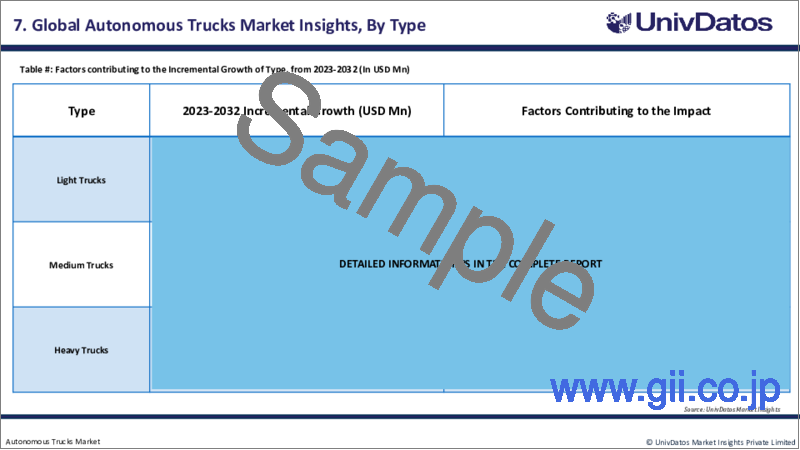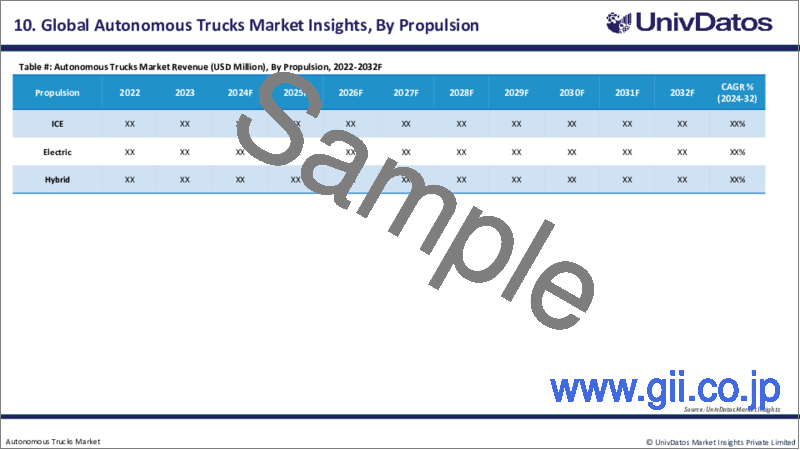|
|
市場調査レポート
商品コード
1496138
自動運転トラックの世界市場:現状分析と予測(2024年~2032年)Global Autonomous Trucks Market: Current Analysis and Forecast (2024-2032) |
||||||
カスタマイズ可能
|
|||||||
| 自動運転トラックの世界市場:現状分析と予測(2024年~2032年) |
|
出版日: 2024年05月01日
発行: UnivDatos Market Insights Pvt Ltd
ページ情報: 英文 145 Pages
納期: 即日から翌営業日
|
全表示
- 概要
- 目次
自動運転トラックの世界市場の2023年の市場規模は4億7,822万米ドルで、予測期間(2024-2032年)のCAGRは約13.78%と力強い成長が見込まれています。市場成長の要因としては、ドライバーの不足、運用コストの削減、商品輸送中のダウンタイムの抑制などが挙げられます。これらの要因と並行して、大手トラックメーカーの多くも自動運転ソリューションプロバイダーとの協業や戦略的提携を行っており、自動運転トラック市場における選択肢の増加により需要をさらに刺激しています。
2021年、Volvo Autonomous SolutionsとAuroraは、ハイウェイ自動運転トラック(クラス8トラック)を共同開発する提携を発表しました。このプロトタイプには、Aurora Driver Technologyと統合されたVolvoトラックの長距離VNLモデルが含まれます。
これとは別に、自動運転トラックに対する民間部門の急速な傾斜と政府の支援も、北米と欧州諸国の主要経済国の多くで市場の成長を促しています。
市場セグメンテーションは、タイプ別に小型トラック、中型トラック、大型トラックに区分されます。キャリア貨物、eコマース部門、倉庫などからのトラックの大部分に対する高い需要を考慮すると、膨大な数の企業が運用コストを削減するために中型および大型の自動運転トラックに期待しています。さらに、大型自動運転トラックは長距離移動も提供し、これは中国、米国などの広大な地域を持つ国々では極めて重要です。これらの国々では、相当数の大都市が海域から離れた場所に位置しているため、大型トラックが物資輸送に重宝されています。さらに、多くの企業がクラス8または33,000ポンドの自動運転トラックに対する需要も置いており、これは大型トラックに対する今後の需要の急増を示すものです。中型および小型自動運転トラックは、輸送におけるフットプリントが比較的小さいです。これらのタイプの車両は主に短・中距離の移動に使用され、市街地での操縦や激しい交通状況への対応にも適しています。この現象に伴い、今後数年間(i.e.2024-2032年)は大型自動運転トラックの需要が支配的となります。
自律性のレベルに基づき、自動運転トラックの世界市場は半自動運転と全自動運転に二分されます。自動運転技術の急速な進歩を考慮すると、全自動運転車への需要が予測数年間の市場成長を導くと予想されます。全自動運転トラックは、疲労、注意散漫、障害などのヒューマンエラーによる事故を潜在的に削減し、予期せぬ出来事により迅速に反応することができます。また、これらのシステムは常に環境を監視し、他の車両との距離をより安全に保ち、安全な速度で巡航し、トラックの燃費効率をさらに向上させます。さらに、多くのeコマース企業が完全自動運転トラックを選択しており、こうしたトラックの需要急増につながっています。
自動運転トラックの市場導入に関する理解を深めるため、世界の自動車市場は北米、欧州、アジア太平洋、その他の地域における世界の存在感に基づいて分析されています。このうち、北米地域が2023年に最大のシェアを占めています。北米には広大な輸送とeコマース市場があり、トラック輸送技術のシフトが期待され、さらに燃費が良く、環境の持続可能性につながっています。さらに、地域の自動車メーカーの多くは、技術プロバイダーとの協力の助けを借りて、自動運転トラックにおける製品提供を強化する計画を発表しています。例えば、2024年、Navistar Inc.と自動運転技術プロバイダーのPlusは、米国の道路に自動運転トラックを導入するための提携を発表しました。プラス社によると、同社のクラス4自動運転トラックを欧州と米国のスカニア、マン、ナビスターのトラックに搭載します。
市場に参入している主要企業には、Volvo AB、BYD Co Ltd、Traton SE、Mercedes Benz Group、Tesla、Daimler Trucks、Waymo、Paccar、Embark、TuSimpleなどがあります。
目次
第1章 市場イントロダクション
- 市場の定義
- 主な目標
- ステークホルダー
- 制限事項
第2章 調査手法または前提条件
- 調査プロセス
- 調査手法
- 回答者プロファイル
第3章 エグゼクティブサマリー
- 業界要約
- セグメント別見通し
- 市場成長の強さ
- 地域展望
第4章 市場力学
- 促進要因
- 機会
- 抑制要因
- 動向
- PESTEL分析
- 需要側分析
- 供給側分析
- 合併と買収
- 投資シナリオ
- 業界考察:大手スタートアップ企業とその独自の戦略
第5章 価格分析
- 地域別価格分析
- 価格に影響を与える要因
第6章 自動運転トラックの世界市場収益、2022-2032年
第7章 タイプ別の市場分析
- 小型トラック
- 中型トラック
- 大型トラック
第8章 市場分析:自動運転レベル別
- 半自動運転
- 全自動運転
第9章 市場分析:コンポーネント別
- LiDAR
- レーダー
- カメラ
- センサー
第10章 市場分析:推進別
- ICE
- 電気
- ハイブリッド
第11章 市場分析:地域別
- 北米
- 米国
- カナダ
- その他北米地域
- 欧州
- ドイツ
- 英国
- フランス
- イタリア
- スペイン
- その他欧州地域
- アジア太平洋地域
- 中国
- 日本
- インド
- オーストラリア
- その他アジア太平洋地域
- 世界のその他の地域
第12章 バリューチェーン分析
- 限界分析
- 市場参入企業一覧
第13章 競合情勢
- 競合ダッシュボード
- 競合市場ポジショニング分析
- ポーターのファイブフォース分析
第14章 企業プロファイル
- Volvo AB
- BYD Co Ltd
- Traton SE
- Mercedes Benz Group
- Tesla
- Daimler Trucks
- Waymo
- Paccar
- Embark Trucks
- TuSimple
第15章 頭字語と前提条件
第16章 付録
Autonomous Trucks are next-generation transportation vehicles equipped with a combination of drive assistance components such as LiDAR, RADAR, Camera, and various types of sensors in combination with robust predictive guidance software that helps the vehicle to drive with little to no human interference. Considering the increasing road accidents as well as curbing operational costs, many fleet management companies have started opting for autonomous trucks.
The Global Autonomous Trucks market was valued at USD 478.22 million in 2023 and is expected to grow at a strong CAGR of around 13.78% during the forecast period (2024-2032). Some of the factors that have contributed to the market growth are shortages of drivers, reduced operational costs, and curbing downtime during goods transportation. Alongside these factors, many of the leading truck manufacturers have also undergone collaboration and strategic partnerships with the autonomous driving solutions provider, which has further instigated the demand with the availability of a growing number of options in the autonomous trucks market.
In 2021, Volvo Autonomous Solutions and Aurora announced their partnership to jointly develop highway autonomous trucks (class 8 trucks). This prototype includes a Volvo truck long-haul VNL model integrated with Aurora Driver Technology.
Apart from this, the rapid private sector inclination towards autonomous trucks and government support has also instigated market growth in many of the leading economies of North America and European countries.
Based on type, the global autonomous trucks market is segmented into light trucks, medium trucks, and heavy trucks. Considering the high demand for a large section of trucks from carrier freight, the e-commerce sector, warehouses, etc., a vast number of companies are looking forward to medium and large autonomous trucks to reduce their operational cost. Additionally, heavy autonomous trucks also provide long-distance travel, which is crucial in countries with vast geography, such as China, the US, etc. In these countries, a substantial number of major urban cities are located distantly from the sea areas, which is why heavy trucks come in handy to transport goods. Additionally, many of the companies have also placed their demand for class 8 or 33,000-pound autonomous trucks, which exhibit the upcoming surge in demand for heavy trucks. Medium and light autonomous trucks have a comparatively smaller footprint in transportation. These types of vehicles are used mainly for short- to medium-distance travel and are also conducive to city maneuvers and to tackle heavy traffic conditions. In line with this phenomenon, the demand for heavy autonomous trucks will dominate in the forthcoming years, i.e., 2024-2032.
Based on the Level of Autonomy, the global autonomous trucks market has been bifurcated into semi-autonomous and fully autonomous. Considering the rapid advancements in self-driving technologies, the demand for fully autonomous cars is anticipated to lead to market growth in the forecasted years. Fully autonomous trucks can potentially reduce the accidents caused by human error, such as fatigue, distraction, and impairment, and react faster to unexpected events. These systems also constantly monitor the environment and maintain a much safer distance from other vehicles, cruising at a safe speed, further enhancing the fuel efficiency of the trucks. Additionally, many e-commerce companies are opting for fully autonomous trucks, leading to a surge in demand for such trucks.
For a better understanding of the market adoption of autonomous trucks, the Global Automotive market is analyzed based on its worldwide presence in regions such as North America, Europe, Asia-Pacific, and the Rest of the World. Of these, the North American region held the largest share in 2023. North America has a vast transportation and e-commerce market, and it is looking forward to a shift in trucking technology, further offering better fuel efficiency and leading to environmental sustainability. Additionally, many of the regional automotive manufacturers have announced their plans to enhance their product offerings in autonomous trucks with the help of collaboration with the technology providers. For instance, in 2024, Navistar Inc. and Plus, an autonomous driving technologies provider, announced their partnership to bring self-driving trucks to US roads. According to Plus, it will use its class 4 autonomous trucks in trucks of Scania, Man, and Navistar in Europe and the USA.
Some of the major players operating in the market include Volvo AB, BYD Co Ltd, Traton SE, Mercedes Benz Group, Tesla, Daimler Trucks, Waymo, Paccar, Embark, and TuSimple.
TABLE OF CONTENTS
1.MARKET INTRODUCTION
- 1.1. Market Definitions
- 1.2. Main Objective
- 1.3. Stakeholders
- 1.4. Limitation
2.RESEARCH METHODOLOGY OR ASSUMPTION
- 2.1. Research Process of the Autonomous Trucks Market
- 2.2. Research Methodology of the Autonomous Trucks Market
- 2.3. Respondent Profile
3.EXECUTIVE SUMMARY
- 3.1. Industry Synopsis
- 3.2. Segmental Outlook
- 3.3. Market Growth Intensity
- 3.4. Regional Outlook
4.MARKET DYNAMICS
- 4.1. Drivers
- 4.2. Opportunity
- 4.3. Restraints
- 4.4. Trends
- 4.5. PESTEL Analysis
- 4.6. Demand Side Analysis
- 4.7. Supply Side Analysis
- 4.7.1. Merger & Acquisition
- 4.7.2. Investment Scenario
- 4.7.3. Industry Insights: Leading Startups and Their Unique Strategies
5.PRICING ANALYSIS
- 5.1. Regional Pricing Analysis
- 5.2. Price Influencing Factors
6.GLOBAL AUTONOMOUS TRUCKS MARKET REVENUE (USD MN), 2022-2032F
7.MARKET INSIGHTS BY TYPE
- 7.1. Light Trucks
- 7.2. Medium Trucks
- 7.3. Heavy Trucks
8.MARKET INSIGHTS BY LEVEL OF AUTONOMY
- 8.1. Semi-Autonomous
- 8.2. Fully Autonomous
9.MARKET INSIGHTS BY COMPONENT
- 9.1. LiDAR
- 9.2. RADAR
- 9.3. Camera
- 9.4. Sensors
10.MARKET INSIGHTS BY PROPULSION
- 10.1. ICE
- 10.2. Electric
- 10.3. Hybrid
11.MARKET INSIGHTS BY REGION
- 11.1. North America
- 11.1.1. U.S.
- 11.1.2. Canada
- 11.1.3. Rest of North America
- 11.2. Europe
- 11.2.1. Germany
- 11.2.2. U.K.
- 11.2.3. France
- 11.2.4. Italy
- 11.2.5. Spain
- 11.2.6. Rest of Europe
- 11.3. Asia-Pacific
- 11.3.1. China
- 11.3.2. Japan
- 11.3.3. India
- 11.3.4. Australia
- 11.3.5. Rest of Asia-Pacific
- 11.4. Rest of World
12.VALUE CHAIN ANALYSIS
- 12.1. Marginal Analysis
- 12.2. List of Market Participants
13.COMPETITIVE LANDSCAPE
- 13.1. Competition Dashboard
- 13.2. Competitor Market Positioning Analysis
- 13.3. Porter Five Forces Analysis
14.COMPANY PROFILED
- 14.1. Volvo AB
- 14.1.1. Company Overview
- 14.1.2. Key Financials
- 14.1.3. SWOT Analysis
- 14.1.4. Product Portfolio
- 14.1.5. Recent Developments
- 14.2. BYD Co Ltd
- 14.3. Traton SE
- 14.4. Mercedes Benz Group
- 14.5. Tesla
- 14.6. Daimler Trucks
- 14.7. Waymo
- 14.8. Paccar
- 14.9. Embark Trucks
- 14.10. TuSimple





